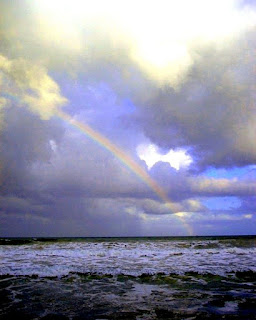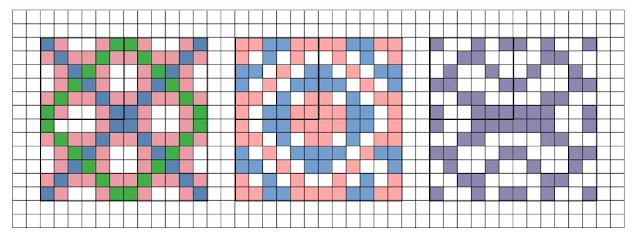It is foggy this morning. Fog is essentially a cloud that has dropped to ground level. The tiny droplets of water that we feel on our faces as mist are not large or heavy enough to fall as rain, nor are they cold enough to start crystallizing into snowflakes. Fog is relatively rare in this high, dry country. It is usually welcome because it brings the promise of rain or snow to this drought-damaged region. I can, however, remember a year when fog lingered from mid-December through mid-January, leaving people short-tempered and depressed. Fog is an emotional thing.
Fog dampens sounds, distorts distances, and interferes with our sense of direction, making it easy to become lost. From an artistic standpoint, it reduces even a complex scene to a few basic shapes. That simplifies the scene and gets rid of a lot of clutter. Only the closest objects and the most distinctive shapes remain. Any source of light or reflection becomes a focal point. On the other hand, fog neutralizes the colors of everything. Fog is gray.
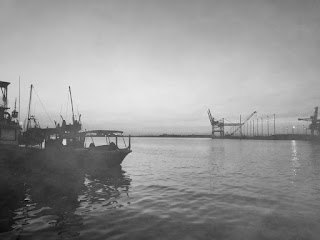 |
| Grey-scale of photo by J.J. |
In
Part I of this series, we showed J.J.'s photograph of sunrise over the harbor. J.D. has shown it here in gray scale as it might have looked on a foggy morning. Old black-and-white snapshots could also give you more ideas for how things might appear in a light fog.
Much of my artwork lately consists of prints J.D. makes from detailed drawings I've done in graphite, charcoal, and black ink, so I am very interested in grays. I work with them practically every day. We think of grays as mixtures of black and white, but that is a very limited view. Very lively grays can be achieved by mixing complementary colors — the ones directly opposite each other on the color wheel. This technique can give you an array of warm grays, cool grays, soft grays, opaque grays, etc.
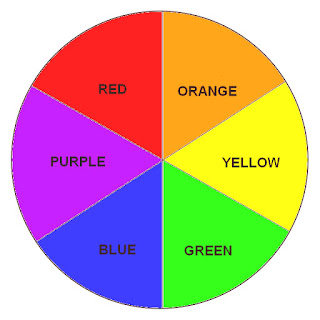 |
| Simple color wheel |
It is a good practice to mix complementary colors in needlepoint, particularly in shadows, which always show some of the complementary color of the object which casts the shadow. You might want to make some reference samples of this kind of work. You can do this with separate strands of floss or yarn. The strands can be twisted together or you can use them separately, side by side. Stitch fine lines of the colors close together on small swatches of fabric or canvas that you can keep for future reference. Hold the finished sample at arm's length to see how the blend appears. Keep and use the combinations you like best. Sometimes you may even get an iridescent effect. Orange and blue are complementary colors. Browns are grouped in the orange family of colors. I have gotten nice results with some mixtures of blues and browns. Try a cool greenish blue with a warm reddish brown, for example, or a purplish blue with a yellowish tan.
*
 |
| Complementary colors from the wheel with their mixed grays |
People have been going to sea for thousands of years. Many must have perished in fog, perhaps tragically close to safe harbors. Seacoast cities began building tall towers with large fires burning on top of them to serve as beacons. The most famous one of these lighthouses was on the island of Pharos by the mouth of the harbor at Alexandria, Egypt. Built by Pharaoh Ptolemy II between 290 and 280 B.C. (BCE), it was one of the Seven Wonders of the Ancient World. It survived for more than 16 centuries before it was destroyed by an earthquake. Writers described it as 450 feet (135 meters) tall. Focused by huge polished bronze mirrors, its light could be seen 40 miles (65 km) at sea. There has recently been a magnificent computer reconstruction of it.
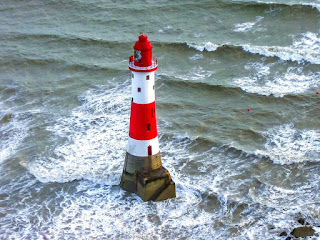 |
| A U.S. lighthouse (public domain photo) |
Many of these lighthouses were built along the coasts of the United States and some of the Great Lakes to guide ships by their fixed or flashing lights. Their use has declined since World War II because so many vessels now use SONAR and GPS positioning systems. A few, mostly remotely controlled, are still in use. Others have become converted to tourist attractions, maritime museums, even private homes. But the lighthouse is still a romantic structure, loved by painters, photographers, and fiction writers. Lighthouses are a popular subject for large photograph calendars. Now that 2019 has already begun, you may find these handsome pictorial calendars on sale for a reduced rate. They are good references for creating your own lighthouse design. Those of you who prefer landscapes to seascapes may be content with the small amount of ocean visible around a lighthouse.
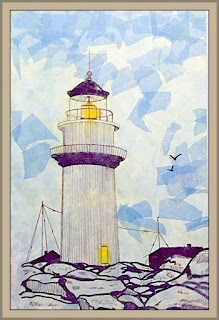 |
| Lighthouse collage by Annake |
This picture is one of my collages, now belonging to J.D. Those of you who are quilters can probably imagine stitching a scene like this on top of a patchwork background. It would also be attractive done in
trapunto, a type of decorative raised quilting, on a pillow top. In trapunto, two parallel lines are stitched through at least two layers of material to outline the design. Then the bottom layer has slits made in it and stuffing is inserted between the lines. If the lines are quite close together, a heavy cord, instead of stuffing, can be worked into the space between the lines.
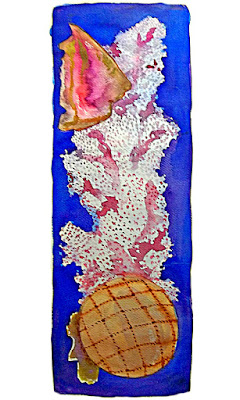 |
| Watercolor study for a wall hanging |
The word
flotsam comes to us from maritime law, where it referred to items deliberately dumped into the ocean from ships. Over the years it has come to mean anything that floats on the water. Much of this flotsam eventually washes up on beaches. Most of it is just garbage that needs to be removed in order to keep the beaches clean and safe. It is unsightly; some of it is dangerous. Nevertheless, an attentive person walking on a beach will find something attractive: pretty seashells, branches of coral, deep-sea fishing lures, glass floats, etc. These objects can be put together in collections or made into artistic arrangements.
The picture at the side of this section of the article is a watercolor sketch for a quickpoint wall hanging. It is 23 inches (58 cm) long and 9 inches (23 cm) wide. When the wall hanging is completed, it could be hung either horizontally or vertically. I think I prefer to hang it vertically, so that is the way I have shown it here. A sketch in progress for a similar composition is shown horizontally, below. I have not chosen a final background color for that composition yet. Those of you who enjoy doing still life designs should enjoy putting together an assortment like one of these. A pattern like one of these, with a wider background, could also be used for a latch-hook rug.
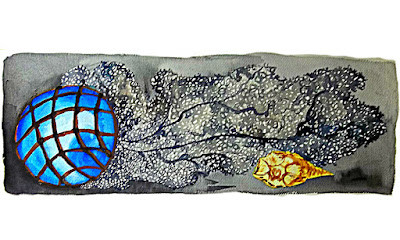 |
| Another watercolor study of flotsam |
Think of a foggy day as a fortunate time to spend with a good book (or sketchbook) or to read blog posts like this one.
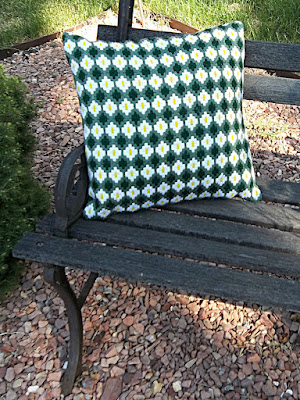

 This post by Annake's Garden is licensed under a Creative Commons Attribution-NonCommercial-ShareAlike 3.0 Unported License.
This post by Annake's Garden is licensed under a Creative Commons Attribution-NonCommercial-ShareAlike 3.0 Unported License.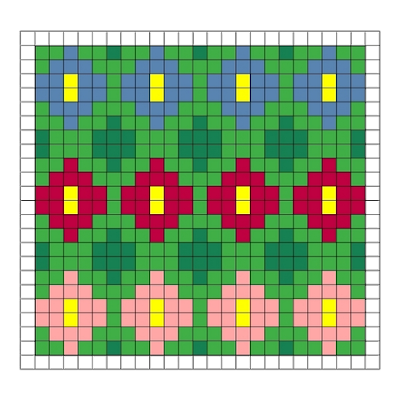



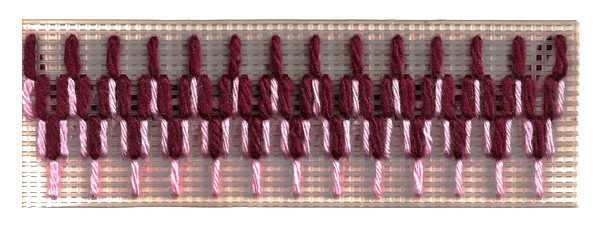
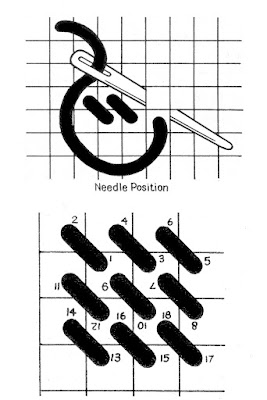
 This post by Annake's Garden is licensed under a Creative Commons Attribution-NonCommercial-ShareAlike 3.0 Unported License.
This post by Annake's Garden is licensed under a Creative Commons Attribution-NonCommercial-ShareAlike 3.0 Unported License.